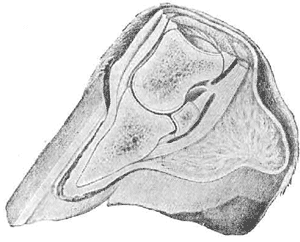Acute laminitus in horses
 The term 'laminitis' is used to indicate a spontaneous and diffuse inflammation of the whole of the sensitive structures of the foot, more particularly the sensitive laminæ. Usually it occurs in the two front feet, often in all four, and occasionally in the hind alone.
The term 'laminitis' is used to indicate a spontaneous and diffuse inflammation of the whole of the sensitive structures of the foot, more particularly the sensitive laminæ. Usually it occurs in the two front feet, often in all four, and occasionally in the hind alone.In the early stages of laminitis there is a state of engorgement of the vessels of the keratogenous apparatus generally, but more particularly the laminal portion of it. With the hoof removed at this stage the sensitive laminae are found to be swollen, dark red in colour, and affording a distinct feeling of increased thickness when pressed between the fingers, Incised, there escapes from the cut surface a large flow of dark venous-looking blood. At this stage hæmorrhages of the laminal vessels occur.
The escaping blood infiltrates the surrounding connective tissue, and in many cases destroys the union between the horny and sensitive laminae. This change is most noticeable in the region of the toe and the commencement of the quarters, the ospedis appearing as though pushed backwards by the escaping fluid collected between the wall and the bone. In severe cases, fortunately but rarely seen, the blood so escaping continues to infiltrate, and separate the tissues until it is seen to be freely oozing at the region of the coronet.
The period of exudation marks the outpouring of the inflammatory fluid. This, even more than the haemorrhages attending the stage of congestion, tends to destroy the intimacy between the sensitive and the horny laminae, leading finally to their complete separation at the region of the toe.
The picture on the right shows this state of affairs after laminitis has existed for a week. The sensitive and horny laminæ are here shown to be distinctly separated from each other, a well-marked cavity existing between them, which cavity is greatest in extent at the toe of the os pedis. With the sensitive structures thus detached from the wall, it is evident that very much that formerly held the os pedis in normal position has been destroyed. What then happens is that the whole of the body-weight is placed upon the sole. Never intended to bear the strain thus imposed, it naturally sinks.
With the sinking is a corresponding 'dropping' of the pedal bone—in fact, of the whole of the bony column. Seeing that the structures above the hoof are still normally adherent to the bones, it follows that they must, as the os pedis sinks, be carried with it. As a consequence we get a marked depression at the coronet, which depression may be often noticed after the second or third week of a severe attack of the disease.
Here, again, though to a greater extent than that caused by the haemorrhage alone, the os pedis appears to be pushed backwards, the space at the toe between the bone and the horny box being closely filled with the yellow, slightly blood-stained exudate.
With the descent of the os pedis we get in many cases a penetration of the horny sole, leading always to serious displacement of the sensitive sole, and often to caries of the exposed bone.
The backward displacement of the os pedis may be accounted for in two ways. Firstly, the greater vascularity of the membrane covering its front leads to a greater outpouring of inflammatory fluid in that particular position. Here, therefore, loss of adhesion with the wall is greatest, while into the cavity so formed is poured a large quantity of a fluid that is practically incompressible.